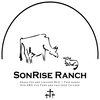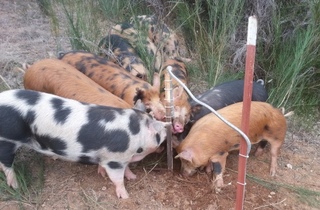 Latest additon to SonRise Ranch - a new Jersey Heifer named "Briar". Born on December 22nd.
Latest additon to SonRise Ranch - a new Jersey Heifer named "Briar". Born on December 22nd. Anyway, we've been there... the romantic thought of having your own milk source. I had a rude awakening years ago when we got our first Milk Cow - I was absolutely amazed at how much work they were. I remember coming back from the barn after milking at 5 AM, before heading off to work that day. I had 8 gallons in my bucket (from one Cow!) and told the kids to start drinking...
"Yep, Dad, we had a few cups, we made Hot Coco", they replied.
So, I went to Eve and asked, "Hey honey, did you get some milk?"
"Yes", she replied, "it tastes great, I even made butter".
"Ok, uh, what are we going to do with this?", as I held up the 8 gallons of fresh milk.
"Just put it in the fridge", she blurted out...
"Sure, sweetie, I will, but the fridge already has 25 gallons of milk in it", I replied.
By the end of that week we had 85 gallons. It was time to call all our friends, and get some pigs (milk fed Pork is really awesome). I learned quickly - Milk Cows are bred to produce!
A few days before Christmas this year, one of our Jerseys had a real nice heifer (female) calf. You can see her in the video above. The Cow in the background is not the calf’s mother. The heifer’s mother approached right after I stopped shooting the video to check me out. She is an excellent mom, and a great producer to boot (about 9 gallons per day).
A few things about calves – first and foremost, Mother Milk Cows cannot keep their calves. Our average Jersey produces between six and ten gallons per day. A calf needs about 1-2 gallons to be healthy, so within a few days of birth, a young calf will be die because it cannot stop drinking her mother’s milk and mama won’t tell them to stop either (she likes the relief). The Calf gets "Scours", or diarrhea, and actually dehydrates as it just can’t process that much liquid.
Our management technique is to separate mother and calf for a portion day and all of the night. Milk calves get a nice warm stall with a heat lamp, during the night, and time with their mothers while mom grazes during the day. Time with mama is limited to a few hours at a time - so as to prevent over-drinking. I tell Eve those darn calves need to join "MA", or, Milk-Anonymous, as they all clearly have a drinking problem.
In the winter, Mother and Calf are together from after morning milking (at about 10 AM) until sundown. It works really well, we end up with a very friendly, easy to lead calf (she is led out and in by us via her halter) and a happy Mom who gets to look after her calf all day. Our Calves also learn herd behavior as the Mother and baby forage with others in the group. Grazing is a learned behavior and calves watch what their Moms eat as they slowly transition from Milk to Grass over about 3 months time. These elements are missing from most Dairy Cows as they are conditioned to live in confinement and only eat grain. We need to have efficient grass-to-milk converters who have heard and grazing skills. This is only the case for our dairy heifers, not our bull calves – bull calves are fed enough milk to grow up and are quickly put on a grazing rotation, so they can be of use as a feeder steers or sold at market.
In theory, it's pretty simple, but in practice, it can be quite challenging. This is something we will teach to each of our apprentice and interns during their time here at SonRise (beginning in 2016). They must know how to manage Milk Cows as they are the center of the sustainable farm operation. Here is a brief summary of how it works…
- 40% of the earth’s surface is grass
- Cows eat grass
- Man cannot eat grass
- Chickens and Pigs can eat grass, but in very small quantities
- Other farm animals eat milk and milk by-products (Chickens, Pigs)
- By correlation Chickens and Pigs eat grass
- Man eats Cows and milk, milk by-products, Chickens and Pigs
- So by correlation, Man eats grass
The pro-GMO world’s talking points include the argument that we can’t feed the world without the large production levels that GMO’s with immunity to pesticides allow. However, I propose that we just use the worlds grass supply, that is, if we can get to the grass before desertification can.





 RSS Feed
RSS Feed